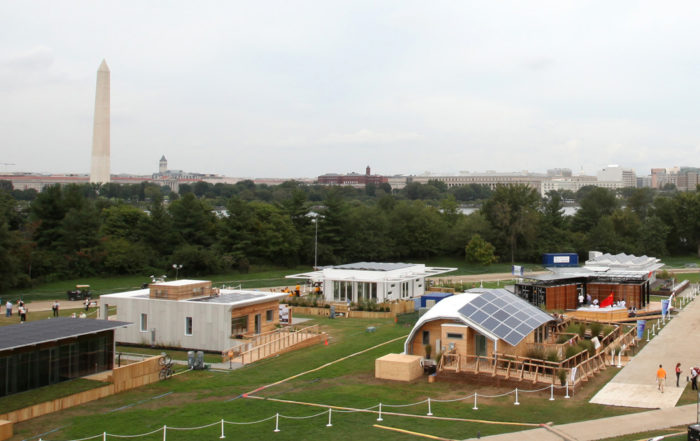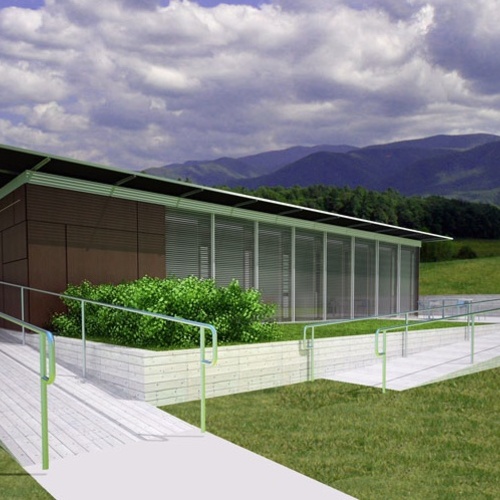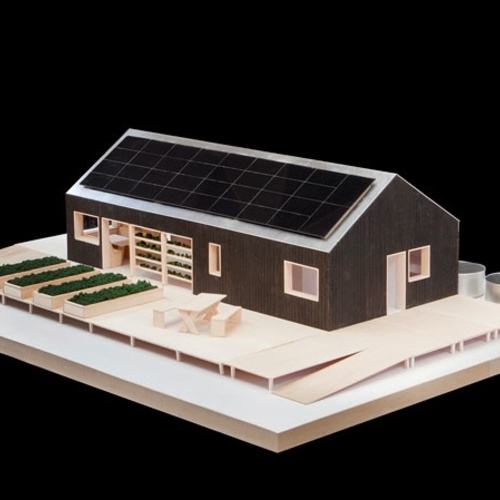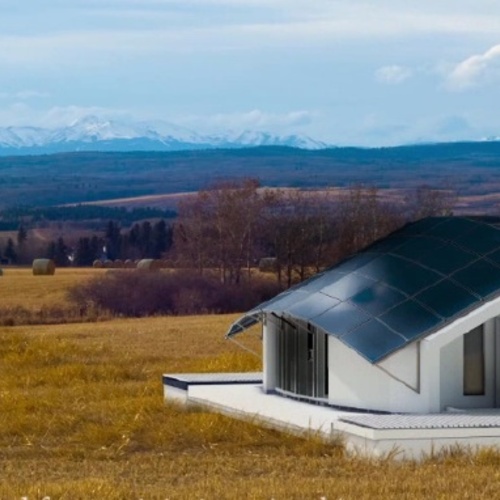Image Credit: Stefano Paltera / U.S. Department of Energy
Image Credit: Stefano Paltera / U.S. Department of Energy Solar Decathlon Director Richard King, at left, joined David Lee, communications manager for Appalachian State University; Allison Wilson, team leader for the University of Maryland; and Mike Hines, project architect for the University of Illinois at Urbana-Champaign, as they fielded questions from viewers during a webcast on September 22.
Image Credit: Department of Energy
For the next several days, “home” for the 19 teams competing in the 2011 Solar Decathlon will be a stretch of the National Mall West in Washington, D.C., that separates the Potomac River from the Tidal Basin.
It is a prestigious address, near both the Franklin Delano Roosevelt Memorial and the Martin Luther King Jr. National Memorial. It has the advantage of being one of the most scenic spots in a city that gets tons of visitors. The roar of commercial jets serving nearby Reagan National Airport might interrupt a conversation of two, but that won’t matter. The Decathlon will be the world’s hottest exhibit of solar-powered homes from September 23 through October 2 – an entire village of remarkable and remarkably diverse solar-powered houses that have been designed, transported, built, and tested by 15 collegiate teams from the U.S. and four from other countries: Belgium, Canada, China, and New Zealand.
To help kick things off, on September 22 Solar Decathlon Director Richard King and three team members – David Lee, communications manager for Appalachian State University; Allison Wilson, team leader for the University of Maryland; and Mike Hines, project architect for the University of Illinois at Urbana-Champaign – took viewer questions during a webcast designed to offer team perspectives on the contest and the two years participants spent preparing their projects for display on the mall.
Affordability – not a typical classroom concern
The competition’s 10 contests include five juried categories – architecture, market appeal, engineering, communications, and affordability – and five measured categories – “comfort zone” (temperature and humidity), hot water, appliances, energy balance (net metering), and home entertainment (which is actually considered both a juried and measured category).
Perhaps more than most other Decathlon contests, the one targeting affordability, which is making its debut in the 2011 Decathlon, seemed to bring the realities of the housing market most closely to bear on the design and construction of the homes, which for this competition had to be built within a size range of 600 to 1,000 sq. ft. (The range for previous Decathlons was 500 to 800 sq. ft.) Homes whose cost comes in at $250,000 or lower earn the contest category maximum of 100 points. Homes costing more than $250,000 lose points on a sliding scale that tapers to zero at the contest limit of $600,000.
The affordability contest, Appalachian State’s Lee noted, significantly changed the way teams dealt with virtually every aspect of the design and construction processes, and forced team members to make “the same tough decisions homeowners do.”
Most architecture students, added University of Maryland’s Wilson, don’t get asked about cost, but as Decathlon contestants, they quickly learned to make cost-effective compromises.
The results of the affordability contest, King said, are due to be announced at 2:30 p.m. September 27.
Building breadth of knowledge
One thing the team members discovered about designing and building by committee is that it requires, well, teamwork – a taste for learning about other disciplines, or at least learning enough to keep the vision for the project intact and its development moving forward.
“You’re forced to bring a lot of people together to make this happen,” observed University of Illinois’ Hines. “What you see here are projects that mimic the real world.”
“In the end, you have a team that’s well versed in everything,” said Lee. From a career-building perspective, added Wilson, the process can open doors. “I’m on my way to being an architect who can speak engineer,” she said.
Dealing with a changing lineup
Asked about the biggest challenges team leaders faced in bringing projects from concept to the mall, the team leaders, interestingly enough, didn’t focus on particulars of design, construction, transport, and cost. Rather, they agreed that because the mix of participants tends to change over two years as people graduate or become immersed in other commitments, bringing new people in and maintaining momentum proved difficult. “That’s a huge challenge,” said Hines. “You’re in an academic environment, but this is a really a full-time-job project. It’s hard to get everybody coordinated. And the project really is fast-paced. I know two years sounds like a long time, but it goes by quickly.”
The process, Wilson emphasized, really is “design by committee. It’s hard.” But she also added that “we all still want to be friends with each other.”
Weekly Newsletter
Get building science and energy efficiency advice, plus special offers, in your inbox.
















0 Comments
Log in or create an account to post a comment.
Sign up Log in